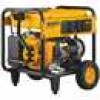Dewalt DXGNR7000 Instruction Manual - Page 15
Starting Pull Start Engines, NOTICE, CAUTION - carburetor
 |
View all Dewalt DXGNR7000 manuals
Add to My Manuals
Save this manual to your list of manuals |
Page 15 highlights
Operation A B B 000400 NOTICE: Allow spilled fuel to evaporate before starting unit. IMPORTANT: It is important to prevent gum deposits from forming in fuel system parts such as the carburetor, fuel hose or tank during storage. Alcohol-blended fuels (called gasohol, ethanol or methanol) can attract moisture, which leads to separation and formation of acids during storage. Acidic gas can damage the fuel system of an engine while in storage. To avoid engine problems, the fuel system should be emptied before storage of 30 days or longer. See the Storage section. Never use engine or carburetor cleaner products in the fuel tank as permanent damage may occur. Starting Pull Start Engines CAUTION Equipment and property damage. Disconnect electrical loads prior to start- ing or stopping unit. Failure to do so could result in equipment and property damage. 1. Unplug all electrical loads from the unit's receptacles before starting engine. 2. Place generator on a level surface. 3. Open the fuel shut-off valve (A). A 000208 4. Turn engine Run/Stop switch (B) to Run (manual start only). 000787 5. Slide engine choke (C) to Full Choke position (left). C 000209 6. Firmly grasp recoil handle and pull slowly until increased resistance is felt. Pull rapidly up and away. 7. When engine starts, move choke knob to 1/2-choke position until engine runs smoothly, then fully into Run position. If engine falters, move choke back to 1/2-choke position until engine runs smoothly, then to Run position. 8. If engine fires, but does not continue to run, move choke lever to Full Choke and repeat starting instructions. IMPORTANT: Do not overload the generator. Also, do not overload individual panel receptacles. These outlets are protected against overload with push-to-reset type circuit breakers. If amperage rating of any circuit breaker is exceeded, that breaker opens and electrical output to that receptacle is lost. Read "Don't Overload the Generator" carefully. Starting Electric Start Engines CAUTION Equipment and property damage. Disconnect electrical loads prior to start- ing or stopping unit. Failure to do so could result in equipment and property damage. 1. Unplug all electrical loads from the unit's receptacles before starting the engine. 2. Place generator on a level surface. 3. Open the fuel shut-off valve. 4. Move engine choke knob outward to Full Choke. 5. Press and hold Start/Run/Stop switch in the Start position. When engine starts, release the switch to the Run position. 6. When engine starts, move choke knob to 1/2 choke position until engine runs smoothly, then fully to RUN position. If engine falters, move choke knob back to 1/2 choke position until engine runs smoothly, then move to Run position. Owner's Manual for Portable Generator 11















